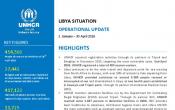Libya
Operation: Libya
Location
{"longitude":17,"latitude":27,"zoom_level":5}
Latest update of camps and office locations 13 Jan 2016. By clicking on the icons on the map, additional information is displayed.
Key Figures
| 2015 end-year results | |
| 2,800 | refugees with compelling protection concerns received direct cash assistance |
| 1,000 | households received core relief items |
| 17,676 | people of concern were provided with primary health care or referred for care by a UNHCR partner |
| 76,103 | IDPs (17% of total IDP population) received direct humanitarian assistance in the form of basic and domestic items |
| 2016 planning figures | |
| 12,500 | households targeted to receive basic and domestic items |
| 20,000 | individuals reached through outreach activities (protection monitoring) |
| 5,000 | refugees and asylum-seekers receive medical support upon disembarkation and in detention |
| 170 | reported SGBV incidents for which 70 survivors receive medical assistance and 100 survivors receive psychosocial counselling |
| 3,000 | households receiving cash assistance |
Latest Updates
People of Concern
18%
Increase in
2015
2015
| 2015 | 471,653 |
| 2014 | 399,935 |
| 2013 | 91,098 |

[["Refugees",9305],["Asylum-seekers",27479],["IDPs",434869]]
Loading ...
Budgets and Expenditure for Libya
< Back
2015
{"categories":[2012,2013,2014,2015,2016],"budget":[31.36360864,18.29967982,19.0845059,20.43036002,21.765039],"expenditure":[12.65725183,6.72035615,7.31457152,8.54921236,null]}
{"categories":[2012,2013,2014,2015,2016],"p1":[14.43788523,13.34674547,16.6945059,18.21231402,16.72037598],"p2":[null,2.16251618,0.34,null,null],"p3":[null,null,null,null,null],"p4":[16.92572341,2.79041817,2.05,2.218046,5.04466302]}
{"categories":[2012,2013,2014,2015,2016],"p1":[8.09127234,6.09107143,6.90089752,6.71457381,null],"p2":[null,0.31574905,0.03065,null,null],"p3":[null,null,null,null,null],"p4":[4.56597949,0.31353567,0.383024,1.83463855,null]}
Loading ...
CHOOSE A YEAR
- 2015
- 2016
Working environment
- Owing to insecurity in Libya, UNHCR operated through remote management, relying on a team of national staff based in Tripoli and Benghazi and the international staff working from Tunis. Security concerns also restricted the movement of national staff, as well as international and local partner NGOs.
- Access to persons of concern remained of concern. UNHCR continued to advocate for increased protection space.
- Refugees and asylum-seekers continued to move along migrant routes and were increasingly vulnerable to intimidation, attacks on religious grounds, arbitrary and indefinite detention, forced labour, exploitation as well as sexual violence.
- Refugees and asylum-seekers were also affected by the ongoing conflict in Libya, which resulted in a rising cost of living, unemployment, a collapsing public health care system, and the closure of many educational institutions.
- Over 435,000 individuals were internally displaced in Libya, with increasing strain on host communities, competition for scarce resources, and frustration among all populations affected by the crisis.
Population trends
- There were nearly 435,000 internally displaced persons (IDPs) by year end.
- 28,000 were registered refugees, also by year end.
- Some 9,000 asylum-seekers were registered as of end of January 2016.
Achievements and impact
- Registration activities were resumed in December 2015 after being suspended for one year.
- Standard operating procedures for registration, cash assistance, telephone hotlines, detention and rescue at sea were finalized to harmonize activities in Libya as well as to facilitate remote monitoring.
- Information management of activities in community development centres, detention, outreach, telephone hotlines, and rescue at sea, as well as partner’s referral mechanism and reporting, were significantly improved.
- The capacities of key stakeholders in the area of refugee law were strengthened.
Unmet needs
- Refugees and asylum-seekers had limited access to assistance and services provided by UNHCR and its partners, including because of security constraints.
- Access to the formal labour market remained restricted, and continued to be strained by insecurity.

